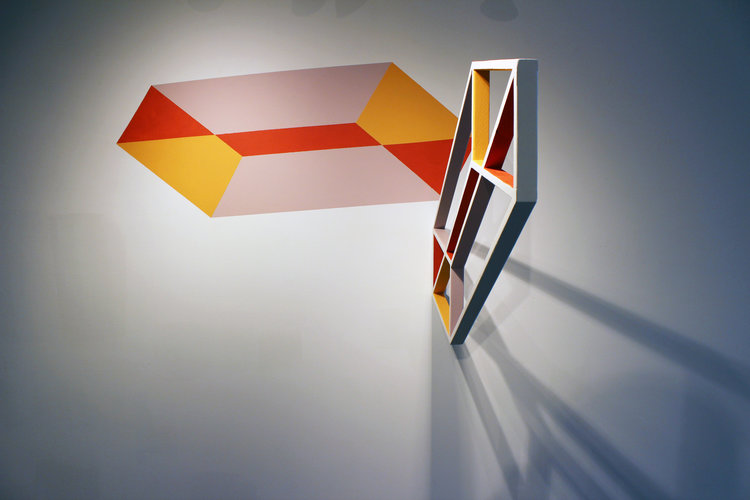
Hey everyone–it’s been a while! Since our last blog post, Root Division has moved into and celebrated one year in our new space at 1131 Mission Street. Root Division’s new 13,400-square-foot home now provides subsidized studio space for 31 artists and has helped us to expand the roster of class offerings to provide arts education to over 2000 youth and adults annually. Our new space now also includes the Frank-Ratchye Studio Artist Project Space, which is a gallery for Root Division artists to connect and engage in dialogue around the work being made on site, and to exhibit their art to the public. The Project Space is located on our rear mezzanine, and is free and open to the public during gallery hours in conjunction with the current exhibition. This space is made possible with the generous support of Ed Frank and Sarah Ratchye.
My name is Lauren Etchells and this month I joined Root Division’s team as the 2016-17 Exhibitions Fellow. I am a Bay Area native and a longtime fan of Root Division, so I am incredibly honored and excited to be working here with RD’s hard-working staff and amazing group of studio artists. I got my start at the University of San Francisco, where I earned my B.A. in Art History/Arts Management and went on to earn my M.A. in Museum Studies at San Francisco State University. In graduate school, I focused on curatorship and was interested how contemporary arts organizations engage the general public through universally accessible exhibitions and interpretive experiences. In addition to my day job as a fundraiser at the Oakland Museum of California, I have spent the past three years teaching an undergraduate gallery exhibitions practicum course at the University of San Francisco and have developed a passion for helping young and emerging artists exhibit their work.
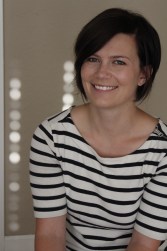
As part of my fellowship here at Root Division, I will be conducting monthly interviews with Root Division Studio Artists whose work is currently or has recently been on display in the Frank-Ratchye Project Space. The first artist I am speaking with is Nicholas Hullibarger, whose work Spatial Binary Six was exhibited in the Frank-Ratchye Project Space during the month of September.
Born and raised in Southeastern Michigan, Nicholas Hullibarger began his career as an artist at Siena Heights University, where he majored in Mixed Media and Art History. He later earned an MFA in Sculpture from the Massachusetts College of Art and Design in Boston. Now a Root Division Studio Artist for just over one year, Hullibarger has begun to focus on space, relational aesthetics and time in his latest work. In his Spatial Binary series, Hullibarger creates a multi-dimensional environment through the use of aesthetic relationships, line, colour, distance and form.
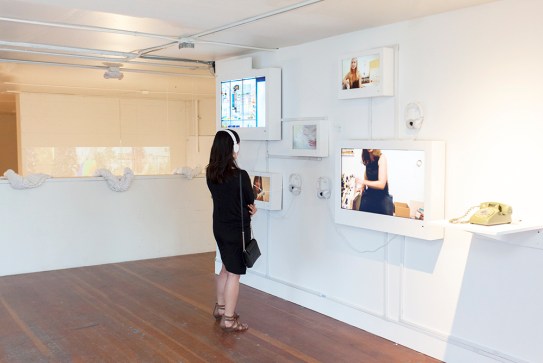
Lauren Etchells: Thanks for taking the time to speak with me today, Nick. Your piece looked great in the Frank-Ratchye Project Space this month. Can you tell me a little more about the thought process behind this body of work?
Nicholas Hullibarger: Ever since graduate school, I have been thinking a lot about space in terms of distance and proximity–moving from point A to point B. Inside all of that time and space that we travel through, that we pass from point A to point B, there’s a whole other kind of life that’s happening. I started thinking “how do we go about navigating that space?” I also work as a museum preparator, so I have a lot of time to think about how museums and galleries make their spaces look the way they do. And so some of those thoughts definitely funnel back into my work.
LE: Can you tell me about some of your earlier work. Some of them look like an earlier iteration of the spatial binaries.
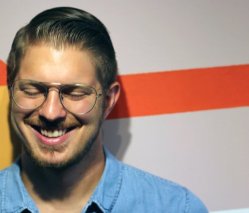
NH: Yeah, with the series Space is neither ‘nothing’ nor ‘something’ I was trying to figure it out. It started with a project that I wrote down in graduate school that I never got around to doing. I started making these open frames and stretching found or used fabric over top of them. And then I started splitting the space of the actual frame in half or in quarters so that half would be fabric and the rest would be open. I decided to drop it, but what came out of those was the frame. I started playing with the various different spatial aspects within the frame. I first started off with the squares and rectangles, having the frame jut out into space, trying to challenge what a frame is. It’s not enough just to paint over the frame and onto the wall and then have it look like it’s a frame. So I started pushing it and they started jutting out into space and I started changing the shapes of them. Then I added the painted wall aspect and started using the polygons within that space and allowed them to become part of the frames.

LE: Do you see the sculptural elements of your work as a frames, sculptures, or both?
NH: I call them frames because I haven’t quite found a better term for them yet. They started off as frames, so it’s still stuck in the way I describe them. Usually when I talk about the work I talk about the painted aspect and the sculptural aspect, and that dichotomy.
LE: Were you always painting the inside of the frames?
NH: When I was first interacting with the binaries, I would put them on the wall and stick my face into the cubes and see what would be seen by the viewer. I could imagine someone doing this in an exhibition and I asked myself “What would they see? How would these guide people to look in certain directions and why?” I thought by painting the inside of the frames, it would guide someone’s eye through the frame and then beyond it. It would bring someone in but it would also encourage them to look at the work from numerous perspectives. I don’t want a singular view. I want to have multiple points of engagement.
LE: How do you determine where you place the painted aspect versus the sculptural aspect?
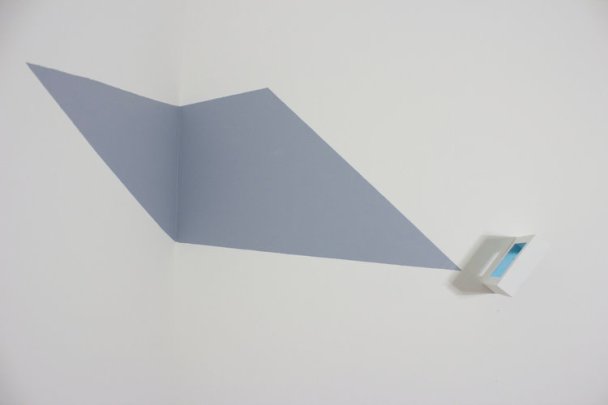
NH: I never really gave myself any rules about them. I tend to enjoy looking for really precarious spots. For the piece that was just up in the Frank-Ratchye Project Space, I put the sculpture up first, set the lighting, and then had the shadow be my baseline for the painting. This process helped me realize that one major rule for my work is that the shadow and the painting can’t cross over one another. The shadow is its own element and has to exist as separately as it can from the painting and the sculpture.
LE: So the lighting is part of the work as well.
NH: Absolutely. I think that has been true since the beginning. As a preparator, I am very conscious of how lighting looks on work. The past couple of times I’ve been able to show the work, I’ve been able to manipulate the lighting to my liking, which has actually been helpful in exploring other avenues and discovering new directions I can take this work in the future.
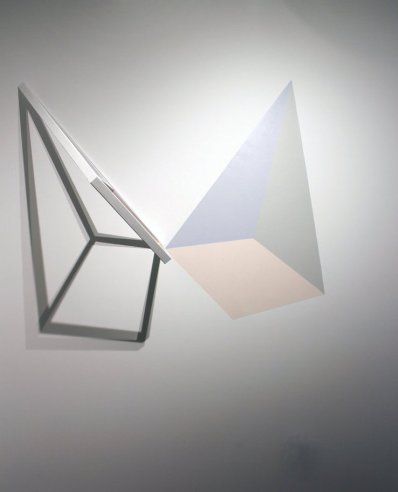
LE: Are there any other artists you’re looking at whose work influences yours?
NH: A large inspiration for my work is the artist Roni Horn. [In her work “Things That Happen Again: For a Here and a There”] she had two copper cones approximately three or four feet in size, and she positioned them so that when you enter the gallery space, the cones look flat and circular. [You can’t see] the points of the cone, but as you approach it and move around it you realize it reveals itself. It isn’t just a copper circle, it’s a cone. And you examine it and judge it for what it is. And then about two or three rooms later yet another one of those “circles” appears again, and it’s another cone, almost identical to that. So you have this reevaluation of space and this reevaluation of your preconceived thoughts you developed in the previous room. There’s a reveal and there’s a second reveal after you’ve already decided that the work is singular. It was one piece but separated by space, separated by different rooms, with no indicator that this is one of two pieces. I found that very intriguing and refreshing because I don’t seem to see many people doing that.
LE: So the lighting is part of the work as well.
NH: Absolutely. I think that has been true since the beginning. As a preparator, I am very conscious of how lighting looks on work. The past couple of times I’ve been able to show the work, I’ve been able to manipulate the lighting to my liking, which has actually been helpful in exploring other avenues and discovering new directions I can take this work in the future.
LE: Are there any other artists you’re looking at whose work influences yours?
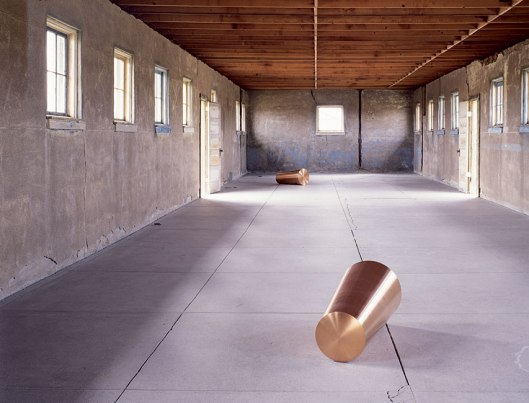
NH: A large inspiration for my work is the artist Roni Horn. [In her work “Things That Happen Again: For a Here and a There”] she had two copper cones approximately three or four feet in size, and she positioned them so that when you enter the gallery space, the cones look flat and circular. [You can’t see] the points of the cone, but as you approach it and move around it you realize it reveals itself. It isn’t just a copper circle, it’s a cone. And you examine it and judge it for what it is. And then about two or three rooms later yet another one of those “circles” appears again, and it’s another cone, almost identical to that. So you have this reevaluation of space and this reevaluation of your preconceived thoughts you developed in the previous room. There’s a reveal and there’s a second reveal after you’ve already decided that the work is singular. It was one piece but separated by space, separated by different rooms, with no indicator that this is one of two pieces. I found that very intriguing and refreshing because I don’t seem to see many people doing that.
LE: Some of these shapes are pretty complicated. Do you think you’re getting less minimalist in your approach?
NH: I would say no. I would say they stay within a range. Sometimes they get super complicated, visually, but they still feel very minimalistic. What I do is focus on the basic elements and principles of design, which is one of the first things you learn in art school. You’ll look at form, shape, color, and those are some of the basic principles. And that’s what this work boils down to.
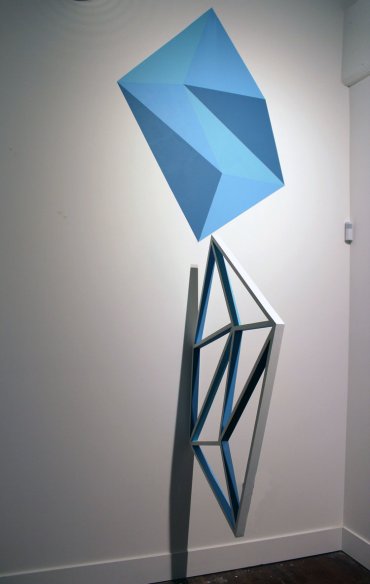
LE: I feel like because your work does boil down to the basics, it is very approachable for people who may not be as well versed in art or art history. It seems like you’re almost trying to teach the viewer how to look at art.
NH: I think that’s always been my intention. I’m teaching in the Adult Education Program at Root Division and I’ve always been interested in education, so it has always been in my nature to want to assist with the process of discovery. I feel that it’s my job as an artist to try and encourage active observation.
LE: What’s it been like teaching and having a studio here at Root Division?
NH: Being part of this community at Root Division has been incredibly helpful. Going into year two, It’s been proving to be more and more helpful in getting me to where I want to be. Root Division helped me build a sort of community in the Bay Area. Root Division moved into this new space the same month that I came on as a studio artist, so it was a wild experience being part of that and chipping in, trying to help. I’ve also been trying to gain more teaching experience so that I can teach at the college level, and Root Division has allowed me to gain that relevant teaching experience. Root Division is one of the few places in the Bay Area that will take a risk on you as an emerging artist, it’s part of their mission. They’ll teach you how to teach, you can pitch different ideas, you can flesh out your syllabus, and that has been one of the major benefits for me. After this year, I’ll have two years of teaching experience, which will serve me well in the long run. Not to mention all the connections that I’ve made. I’m slowly starting to get more shows.
LE: Well, congratulations on this latest opportunity. I look forward to seeing more of your work in the future.
This fall, Nicholas will be teaching Drawing 101, Figure Drawing, Introduction to Adobe Illustrator, and Sculpture as part of Root Division’s Adult Education Program. You can see more of his work on his website and in the upcoming RAWsf showcase Verve on October 26th. Plus, don’t miss his piece in Root Division’s 15th Annual Art Auction on Thursday, October 27th. Tickets are on sale now!
Stay tuned for more interviews with our Root Division Studio Artists here on our blog, and don’t forget to check out the Frank-Ratchye Studio Artist Project Space in our new home at 1131 Mission Street. Next up in the Project Space for the month of November is work by Root Division Studio Artist Margaret Timbrell.
